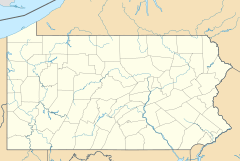List of forts in Washington County, Pennsylvania facts for kids
This article is about the old forts in Washington County, Pennsylvania. Long ago, during the time of the early American colonies and the American Revolutionary War, this area was known as the frontier. This meant it was the edge of settled lands, close to where Native American tribes lived. These forts were like safe houses. They gave protection to the settlers from attacks by the Native Americans who were already living there.
Contents
Famous Forts in Washington County
Doddridge's Fort
|
Pennsylvania Historical Marker
|
|
| Location | Pa. 844 west of Pa. 231 at Sugar Run Road, 2.5 miles (4.0 km) west of West Middletown, Pennsylvania |
|---|---|
| Coordinates | 40°14′55″N 80°28′20″W / 40.24851°N 80.47213°W |
| Built/founded | circa 1773 |
| PHMC dedicated | May 28, 1947 |
Doddridge's Fort was a group of log cabins surrounded by a strong fence called a stockade. It was built around 1773 by John Doddridge. Its purpose was to be a safe place for settlers living in the area. This fort was located in what is now Independence Township, Washington County, Pennsylvania.
The fort was also a common stop for traveling preachers, like Francis Asbury. It was the childhood home of Joseph Doddridge, who wrote an important book about the settlement and wars with Native Americans. His brother, Philip Doddridge, also grew up here.
On May 28, 1947, a special marker was put up by the Pennsylvania Historical & Museum Commission. This marker is on Pa. 844, about 2.5 miles (4.0 km) west of West Middletown, Pennsylvania. It tells people about the fort's importance in Pennsylvania's history. The actual fort was a bit north of where the marker is today.
Lindley's Fort
Lindley's Fort was a type of strong building called a blockhouse. It was set up by a settler named Demas Lindley. It was located near Ten Mile Creek, in what is now the village of Prosperity in Morris Township, Washington County.
A local historian named Alfred Creigh said it was "one of the strongest forts in the western country." This was because it was often in danger from Native American attacks. When danger was high, settlers would build extra cabins near the fort. This allowed them to quickly move inside the fort's walls for safety.
In 2011, there was a discussion about Lindley's Fort. Some experts and historians were worried that a company planned to build a road for natural gas drilling right through this important historical site.
Miller's Blockhouse
|
Pennsylvania Historical Marker
|
|
| Location | U.S. 40, 3.5 miles (5.6 km) west of Claysville |
|---|---|
| Coordinates | 40°06′34″N 80°29′42″W / 40.10934°N 80.49506°W |
| Built/founded | circa 1780 |
| PHMC dedicated | May 28, 1947 |
Miller's Blockhouse was a strong, fortified building. It was built around 1780 by Jacob Miller, Sr., who was an early settler in the frontier area of what is now Washington County, Pennsylvania. This fort helped protect settlers in the Dutch Fork area from attacks by Native Americans. On March 31, 1782, the fort was attacked. A brave woman named Ann Hupp led a heroic defense of the fort.
On May 28, 1947, the Pennsylvania Historical & Museum Commission placed a historical marker for Miller's Blockhouse. It is on U.S. 40, about 3.5 miles (5.6 km) west of Claysville. This marker highlights the fort's importance to the history of Pennsylvania. The actual spot where the blockhouse stood is about 3 miles (4.8 km) north of the marker.
Rice's Fort
|
Pennsylvania Historical Marker
|
|
| Location | U.S. 40 at Lake Road, 3.5 miles (5.6 km) west of Claysville |
|---|---|
| Coordinates | 40°07′16″N 80°28′28″W / 40.12103°N 80.47432°W |
| PHMC dedicated | 1973 |
Rice's Fort was another strong blockhouse in what is now Washington County, Pennsylvania. It was built by Abraham Rice along Buffalo Creek during the American Revolutionary War. In September 1782, the people inside the fort successfully defended it from a long attack by Native Americans. This attack was written about in a history book from 1883.
In 1973, the Pennsylvania Historical & Museum Commission put up a historical marker for Rice's Fort. It is located on U.S. 40 at Lake Road, about 3.5 miles (5.6 km) west of Claysville. This marker helps remember the fort's role in Pennsylvania's history.
Wolff's Fort
|
Pennsylvania Historical Marker
|
|
| Location | U.S. 40, 3.3 miles (5.3 km) southwest of Washington |
|---|---|
| Coordinates | 40°09′02″N 80°19′24″W / 40.15056°N 80.32347°W |
| Built/founded | circa 1780 |
| PHMC dedicated | May 28, 1947 |
Wolff's Fort was a log house surrounded by a stockade fence. It was built around 1780 by Jacob Wolfe. The Pennsylvania Historical & Museum Commission says it was "one of the most important forts in the area."
On May 28, 1947, the Pennsylvania Historical & Museum Commission placed a historical marker for Wolff's Fort. It is on U.S. 40, about 3.3 miles (5.3 km) southwest of Washington. This marker helps people learn about the fort's importance to the history of Pennsylvania.


